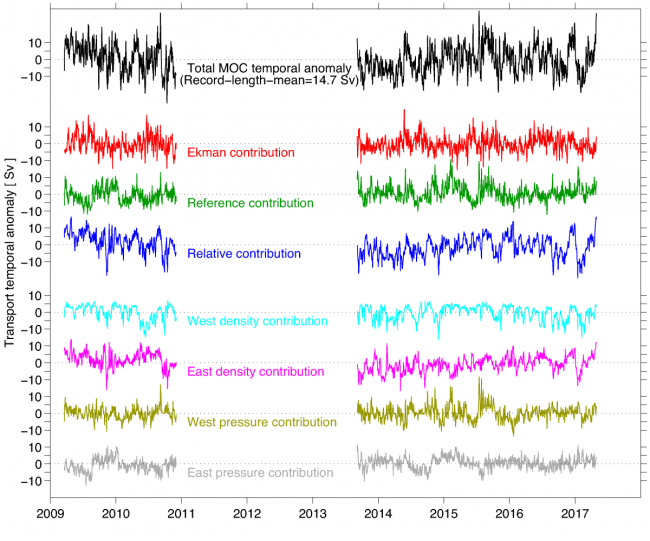Dynamic and complex variability of the Atlantic Meridional Overturning Circulation at 34.5S
The Meridional Overturning Circulation (MOC) is an important component of the global ocean circulation system. The MOC is a global pattern, dominating the oceanic exchange of water (as well as heat, salt, and carbon) between ocean basins and across latitudes within the basins. In the Atlantic, the MOC (commonly known as AMOC) is characterized primarily by north-south flows and vertical exchanges between the surface and the deep ocean. Numerical climate models show that MOC variations are correlated with important worldwide climate variations, including changes in precipitation, air temperatures, coastal sea levels, and extreme weather events (e.g., drought, heat waves). Continuous daily observations of the MOC transport in the North Atlantic have been available for more than a decade. However, similar observations have not been available in the South Atlantic despite the fact that theoretical and modeling studies of the mechanisms controlling the AMOC have suggested that MOC stability is controlled by interocean exchange between the South Atlantic and Southern Oceans. A recent paper published in Geophysical Research Letters presents, for the first time, a multi-year record of the daily MOC volume transports at 34.5°S in the South Atlantic Ocean based on direct measurements. The international team of scientists behind the paper used six years of simultaneous moored observations together with satellite winds to produce this new MOC volume transport record.

The results of this study illustrate some interesting differences between the observed MOC variability at 34.5°S in the Atlantic and the observed MOC variability from the more established array at 26.5°N. The new study, in particular, demonstrates that variations in density and bottom pressure are both playing significant roles in the total MOC variability at 34.5°S and variations near both the South American and African continental shelves impact MOC changes at daily, seasonal, and interannual timescales. These results contrast with the observations at 26.5°N, where previous work suggested that eastern boundary variations only had a role at annual timescales, and that MOC variability at 26.5°N at both sub-annual and interannual timescales was dominated solely by variations at the western boundary. The new results at 34.5°S indicate that the South Atlantic is a bit more dynamic and complex than the North Atlantic, and that to properly observe daily to interannual MOC variability it is crucial to measure the barotropic and baroclinic components of the flow at both sides of the basin, as well as the Ekman transport.
Meridional Overturning Circulation transport variability at 34.5°S during 2009-2017: Baroclinic and barotropic flows and the dueling influence of the boundaries (Geophysical Research Letters)
1NOAA Atlantic Oceanographic and Meteorological Laboratory
2IPSL, Ecole Normale Supérieure, France
3Servicio de Hidrografía Naval, Argentina
4Universidad de Buenos Aires, Argentina
5CONICET, Argentina
6University of Cape Town, South Africa
7University of São Paulo, Brazil
8Federal University of Ceará, Brazil
9University of Miami
10IFREMER, Univ. Brest, CNRS, IRD, LOPS, IUEM, France
11Department of Environmental Affairs, South Africa
Topics
- Ocean Heat
- Atlantic Ocean
- AMOC
